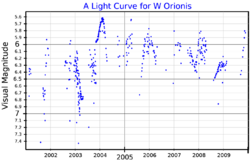Astronomy:W Orionis
From HandWiki
Short description: Star in the constellation Orion
| Observation data Equinox J2000.0]] (ICRS) | |
|---|---|
| Constellation | Orion |
| Right ascension | 05h 05m 23.72142s[2] |
| Declination | +01° 10′ 39.4512″[2] |
| Apparent magnitude (V) | 4.4 - 6.9[3] |
| Characteristics | |
| Evolutionary stage | AGB |
| Spectral type | C-N5 C25.5[4] (C5,4(N5)[5]) |
| U−B color index | +6.84[6] |
| B−V color index | +3.42[6] |
| Variable type | SRb[5] |
| Astrometry | |
| Radial velocity (Rv) | +16.50[7] km/s |
| Proper motion (μ) | RA: +7.5[2] mas/yr Dec.: -1.4[2] mas/yr |
| Parallax (π) | 2.65 ± 0.95[2] mas |
| Distance | approx. 1,200 ly (approx. 400 pc) |
| Absolute magnitude (MV) | −5.76[8] |
| Details | |
| Mass | 1-2[9] M☉ |
| Radius | 406[9] R☉ |
| Luminosity | 6,761[9] L☉ |
| Surface gravity (log g) | −0.60[9] cgs |
| Temperature | 2,600[9] K |
| Metallicity [Fe/H] | 0.0[9] dex |
| Other designations | |
W Ori, BD−00°939, HD 32736, HIP 23680 | |
| Database references | |
| SIMBAD | data |
W Orionis is a carbon star in the constellation Orion, approximately 400 parsecs (1,300 ly) away. It varies regularly in brightness between extremes of magnitude 4.4 and 6.9 roughly every 7 months.
Variability
W Orionis is a semiregular variable with an approximately 212‑day cycle.[5] A long secondary period of 2,450 days has also been reported.[10]
Properties
The angular diameter of W Orionis has been measured using interferometry and a value of 9.7 mas is found. Although it is known to be a pulsating variable star, no changes in the diameter were seen.[9]
Technetium has not been detected in W Orionis, an unexpected result since this s-process element should be dredged up in all thermally-pulsating AGB stars and especially in carbon stars.[9]
References
- ↑ "ASAS All Star Catalogue". The All Sky Automated Survey. http://www.astrouw.edu.pl/asas/?page=aasc.
- ↑ 2.0 2.1 2.2 2.3 2.4 Van Leeuwen, F. (2007). "Validation of the new Hipparcos reduction". Astronomy and Astrophysics 474 (2): 653–664. doi:10.1051/0004-6361:20078357. Bibcode: 2007A&A...474..653V.
- ↑ Watson, C. L; Henden, A. A; Price, A (2006). "The International Variable Star Index (VSX)". The Society for Astronomical Sciences 25th Annual Symposium on Telescope Science. Held May 23–25 25: 47. Bibcode: 2006SASS...25...47W.
- ↑ Barnbaum, Cecilia; Stone, Remington P. S; Keenan, Philip C (1996). "A Moderate-Resolution Spectral Atlas of Carbon Stars: R, J, N, CH, and Barium Stars". Astrophysical Journal Supplement 105: 419. doi:10.1086/192323. Bibcode: 1996ApJS..105..419B.
- ↑ 5.0 5.1 5.2 Samus, N. N. et al. (2009). "VizieR Online Data Catalog: General Catalogue of Variable Stars (Samus+ 2007-2013)". VizieR On-line Data Catalog: B/GCVS. Originally Published in: 2009yCat....102025S 1. Bibcode: 2009yCat....102025S.
- ↑ 6.0 6.1 Ducati, J. R (2002). "VizieR Online Data Catalog: Catalogue of Stellar Photometry in Johnson's 11-color system". CDS/ADC Collection of Electronic Catalogues 2237. Bibcode: 2002yCat.2237....0D.
- ↑ Gontcharov, G. A (2006). "Pulkovo Compilation of Radial Velocities for 35 495 Hipparcos stars in a common system". Astronomy Letters 32 (11): 759–771. doi:10.1134/S1063773706110065. Bibcode: 2006AstL...32..759G.
- ↑ Guandalini, R; Cristallo, S (2013). "Luminosities of carbon-rich asymptotic giant branch stars in the Milky Way". Astronomy & Astrophysics 555: A120. doi:10.1051/0004-6361/201321225. Bibcode: 2013A&A...555A.120G.
- ↑ 9.0 9.1 9.2 9.3 9.4 9.5 9.6 9.7 Cruzalèbes, P; Jorissen, A; Rabbia, Y; Sacuto, S; Chiavassa, A; Pasquato, E; Plez, B; Eriksson, K et al. (2013). "Fundamental parameters of 16 late-type stars derived from their angular diameter measured with VLTI/AMBER". Monthly Notices of the Royal Astronomical Society 434 (1): 437–450. doi:10.1093/mnras/stt1037. Bibcode: 2013MNRAS.434..437C.
- ↑ Olivier, E. A; Wood, P. R (2003). "On the Origin of Long Secondary Periods in Semiregular Variables". The Astrophysical Journal 584 (2): 1035. doi:10.1086/345715. Bibcode: 2003ApJ...584.1035O.
External links
- W Orionis Kaler's Stars
- Astronomy Picture of the Day
 |


